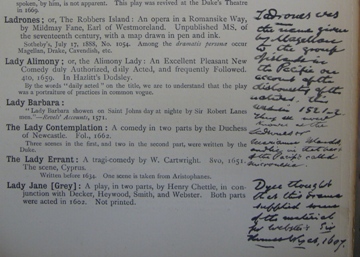Ladrones, or The Robbers' Island
Mildmay Fane, Earl of Westmoreland (1658)
Historical Records
Tom Cain notes that a manuscript entitled Ladrones or the Robbers’ Iland, an Opera in a Romansike Way was “lot 1,054 in the 1887 Sotheby’s sale” and that “[i]t was bought by Toovey for £3 3s, but has since vanished” (27). Harbage (PLMA 690) adds the specific date of the Sotheby's sale: 17 July 1888.
Theatrical Provenance
Unknown.
Probable Genre(s)
Foreign history, recent history, voyage drama.
Possible Narrative and Dramatic Sources or Analogues
 Detail of Hazlitt's marginalia, p127 Courtesy of the Folger Shakespeare Library |
Harbage notes that "Drake, Cavendish, and Magellan figure in the dramatis personae" (PMLA 690).
Magellan and the Ladrones
Hazlitt (127n, see image) notes in the marginal annotations of his personal copy of A manual for the collector and amateur of old English plays that:
Ladrones was the name given by Magellan to the group of islands in the Pacific on account of the dishonesty of the natives. This was in 1521-2. They are ever known as the Ladrones or Marianas Islands and lie in that part of the Pacific called Micronesia.
The story of Magellan's discovery and naming of the Ladrones is thus apparent; the experiences of Drake and Cavendish in this part of the Pacific are less clear.
Cavendish and the Ladrones
Francis Pretty's 1588 account (in Hakluyt 1599) tells us that Cavendish's fleet arrived at the Ladrones on 03 January 1588, where they traded with the "60 or 70 sailes of canoas full of Sauages, who came off to sea vnto vs, and brought with them in their boates plantans, cocos, potato rootes, and fresh fish, which they had caught at sea, and helde them vp vnto vs for to truck or exchange with vs" (817). Pretty relates that when the Englishmen had concluded their trade with the natives, "yet we could not be rid of them. For afterward they were so thicke about the ship, that it stemmed & brake 1 or 2 of their canoas" (817). The English resort to firing their "harquebuzes" (arquebuses; a muzzle-loaded firearm) at the natives, but with no obvious effect (the natives dove into the water) (818).
In 1613 Purchase alludes to Pretty's story in Hakluyt also:
they are best knowne, are knowne by the name of Theeues; a name fitting their nature and disposition. Thus did Magellane find them from whom (besides other things) they stole his boate, which by force he was forced to recouer. Such did our Countrey men in Maister Candishes renowned Voyage finde them, who saw also their Images of wood in the head of their boates, like the Images of the Deuill; Temple, and Saint, best fitting their devotions... (Purchase his pilgrimage 738)
Purchase reproduces Francis Pretty's account in the 1625 edition of Purchase His Pilgrims.
Peter Heylyn provides a concise summary of the English knowledge of the islands in his Cosmographie (1652):
LOS LADRONES are certain Ilands situate betwixt the main Land of America and the Philippine Ilands, in the Longitude of 185. and the 4. Degree of Northern Latitude. So called by Magellanus who first discovered them, because of the thievishness of the Inhabitants, (Insulae Latronum is their name in Latine) who had stollen his Cock boat, which he was forced by main force to recover from them. And they continue still both their name and nature. Found such by Cavendish and Noert in their several Voyages, to whom they came under colour of buying Iron (a commodity which they highly prize) but either closely or openly stealing whatsoever they met with. The people tall of stature, brown of complexion, and inclining to corpulencie; extremely active, and good Divers, continuing a long time under the water, as if alike fitted to both Elements; insomuch as the Hollanders then with Noort, to make trial of it, cast five peeces of Iron into the Sea, all fetched out by one of them: The women as good at it as the men. Both Sexes given to filthy and promiscuous lusts; for which branded (many of them) with the marks of their incontinencie, the Pox having eaten off both their Lips and Noses.
Their Religion is worshipping the Devil, whose Images they have in wood on the head of their Boats; the Chappel and the Saint fit for such devotions. But for the nature of these Ilands, and what subjection the Inhabitants of it yield to the King of Spain, I am yet to seek. But like enough they yield as little as some others do, which yet are reckoned by our Authors to be parts of America. (178)
References to the Play
Only the Sotheby's catalogue described by Cain and Harbage.
Critical Commentary
In the context of Davenant's hybrid entertainments of the Interregnum ("part debate, part opera, part masque, and part play" [Clare 832]) whose generic form was a necessity, because it “enabled them to circumvent the prohibition of 1642, subsequently reinforced, on the presentation of plays” (Clare 832), McInnis argues that "Mildmay Fane, Earl of Westmoreland, appears to have taken a similar approach with a lost entertainment of his own," noting that the full title Ladrones or the Robbers’ Iland, an Opera in a Romansike Way suggests its similar incorporation of music (186n).
For What It's Worth
The Mariana (Marianas) Islands in the Pacific were known as the Ladrones, from the Spanish Islas de los Ladrones, Islands of Thieves.
Hazlitt's printed entry for the play (p127) reads:
Ladrones; or, The Robbers Island: An opera in a Romansike Way, by Mildmay Fane, Earl of Westmoreland. Unpublished MS. of the seventeenth century, with a map drawn in pen and ink.
- Sotheby’s, July 17, 1888, No. 1054. Among the dramatis personæ occur Magellan, Drake, Cavendish, etc.
Works Cited
Site created and maintained by David McInnis, University of Melbourne; updated 19 March 2011.